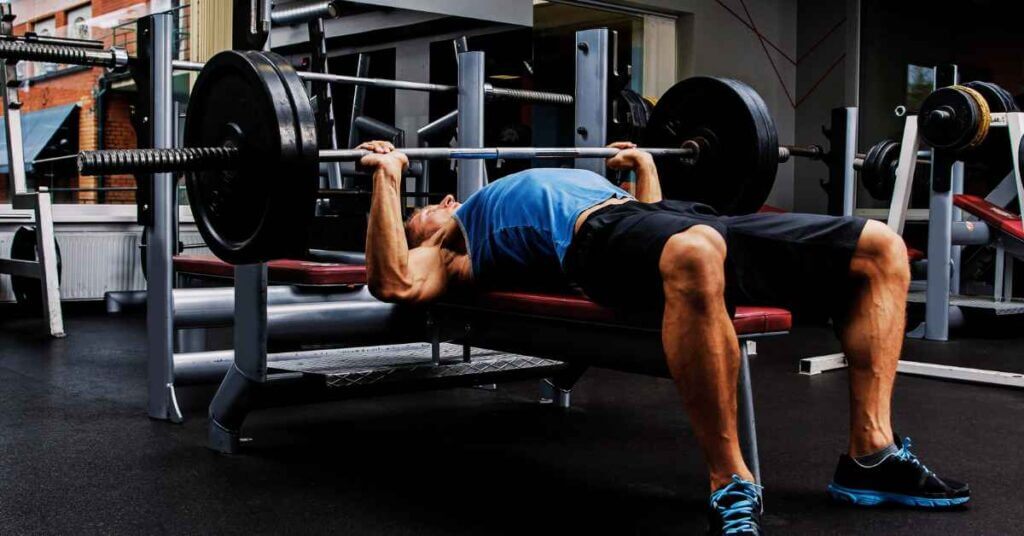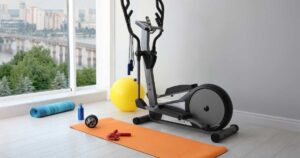List of 5 Must-Try Exercises that Start with K (How To Perform, common mistakes to avoid, tips, Intensity level, Muscles Worked, And Average Calorie Burn)
Greetings, In this article, we will discuss the exercises that start with ‘k.’ Before we get into that, we have already provided detailed and informative content on exercises that start with C, O, E, D, and H. You can find the links to those discussions below.
Now let’s get started and spice up your fitness routine with these 5 must-try exercises that start with k.
5 Must-Try Exercises That Start With K
- Kettlebell Swings
- Knee Push-Ups
- Kneeling Shoulder Tap
- Kettlebell Lunges
- Knee Raises
Kettlebell Swings
Kettlebell swings are an incredible exercise that targets multiple muscle groups while providing a killer cardio workout. This dynamic exercise involves swinging a kettlebell between your legs and up to chest height using the power of your hips, glutes, and core.
How To Perform:
- Start by standing with your feet shoulder-width apart and the kettlebell between your legs. Make sure to maintain a slight bend in your knees.
- Bend at the hips and lower yourself into a squat position, gripping the kettlebell with both hands while keeping your back straight.
- Engage your core and drive through your heels as you swing the kettlebell forward, using the momentum from your hip thrusts to lift it to chest level.
- As the kettlebell reaches its peak, allow it to swing back down between your legs by hinging at the hips again, maintaining control throughout the movement.
- Repeat this swinging motion for several reps, focusing on using proper form and engaging your glutes, hamstrings, and core muscles.
Common Mistakes to Avoid While Doing Kettlebell Swings:
- One common mistake is using too much arm strength instead of relying on the power of your hips and legs. Remember, the momentum should come from the hip hinge movement, not from swinging your arms forcefully. Engage your core muscles and focus on driving through with your lower body.
- Another mistake is not maintaining proper form throughout the entire range of motion. It’s important to keep your back straight, shoulders down and relaxed, and knees slightly bent at all times during the swing.
- Avoid rounding or arching your back as this can strain your spine.
- Using a weight that is too heavy is another mistake to avoid. Start with a lighter kettlebell until you have mastered the correct technique and built up enough strength to handle heavier weights safely.
- Lastly, rushing through each rep without focusing on control can lead to poor execution and reduced effectiveness.
Tips to Maximize the Effectiveness of Kettlebell Swings:
- The first tip is to focus on proper form. Proper form is crucial when performing kettlebell swings. Start with a light weight and concentrate on mastering the correct technique before increasing the intensity.
- Keep your back straight, hinge at the hips, and use your glutes to power the swing.
- A strong core is essential for stability and control during kettlebell swings. Make sure to brace your abs throughout the movement to protect your lower back and generate more power from your hips.
- Use Your Hips, Not Your Arms. Many people make the mistake of relying too much on their arms to lift the kettlebell, which can lead to strain or injury. Instead, focus on driving through your hips explosively as you swing the bell upward.
Intensity level:
Kettlebell swings are a high-intensity exercise that can get your heart pumping. The intensity level of kettlebell swings can vary depending on factors like the weight of the kettlebell you’re using and your fitness level.
For beginners, it’s recommended to start with a lighter kettlebell and focus on mastering the technique before increasing the weight. As you become more comfortable and stronger, you can gradually increase the intensity by using heavier kettlebells or performing more repetitions.
Muscle worked:
- One of the main muscle groups targeted is the posterior chain, which includes your glutes (butt muscles), hamstrings (back of the thighs), and lower back.
- Additionally, your hamstrings work hard to control and stabilize the swinging motion as they contract to decelerate the kettlebell’s downward momentum. By doing so, they also aid in preventing potential injuries by providing stability to your knees.
- Moreover, Kettlebell Swings engage your core muscles, including rectus abdominis (six-pack abs) and obliques (side abdominal muscles).
- Other supporting muscle groups like quadriceps (front of thighs), deltoids (shoulders), trapezius (upper back), forearms, and grip strength get activated during Kettlebell Swings to assist with maintaining balance and control over the kettlebell.
Average Calorie Burn:
Kettlebell swings are not only a great exercise for building strength and endurance, but they can also help you burn a significant amount of calories. The average calorie burn during kettlebell swings depends on various factors such as your weight, intensity level, and duration of the workout.
On average, a person weighing around 150 pounds can expect to burn approximately 20 calories per minute while performing kettlebell swings.
Knee Push-Ups
Knee push-ups are a modified version of the classic push-up exercise that provides numerous benefits for individuals of all fitness levels. This variation is particularly beneficial for beginners or those recovering from injuries.
How To Perform:
- Start by positioning yourself on all fours, with your hands shoulder-width apart and your knees hip-width apart. Your body should form a straight line from head to knees.
- Lower your upper body towards the floor by bending your elbows, keeping them close to your sides. Aim for a 90-degree angle at the bottom of the movement.
- Pause for a moment at the bottom position, then push through your palms to extend your arms and return to the starting position.
- Remember to engage your core muscles throughout the exercise and maintain proper alignment of your spine.
- Repeat this movement for a desired number of repetitions or as recommended by your fitness level or trainer.
Common Mistakes to Avoid While Doing Knee Push-Ups:
- One mistake is arching the lower back. It’s important to maintain a neutral spine throughout the movement.
- Avoid letting your hips sag or sticking your butt up in the air. Engage your core muscles and keep your body in a straight line from head to knees.
- Another mistake is rushing through the exercise. Slow and controlled movements are key for building strength and stability. Take your time with each rep, focusing on proper form and engaging the right muscles.
- Additionally, avoid flaring out your elbows too wide during knee push-ups. Keep them tucked close to your sides as you lower yourself down towards the ground. This will put less strain on your shoulders and help target the chest muscles more effectively.
- Don’t forget about breathing! Many people hold their breath while performing exercises like push-ups. Remember to inhale as you lower yourself down, and exhale as you push back up.
Tips to Maximize the Effectiveness of Knee Push-ups:
- To get the most out of your knee push-ups, it’s important to maintain proper form. Keep your hands shoulder-width apart and position your knees directly under your hips. Your body should form a straight line from head to knees.
- Don’t forget to engage your core muscles while performing knee push-ups. This will help stabilize your body and improve overall strength.
- Focus on Slow and Controlled Movements. Instead of rushing through the exercise, focus on slow and controlled movements. This will allow you to fully engage the targeted muscles and avoid unnecessary strain or injury.
- As you become stronger, gradually increase the difficulty level by extending one leg straight behind you instead of using both knees for support.
- Remember to breathe throughout the exercise inhale as you lower yourself down, and exhale as you push back up.
Intensity level:
When it comes to intensity, knee push-ups are a great exercise option for beginners or those who want to build up their upper body strength gradually. The intensity level of knee push-ups can vary depending on factors such as your fitness level and the number of repetitions you perform.
For someone just starting, knee push-ups provide a less challenging modification compared to traditional push-ups. By placing your knees on the ground instead of keeping your body in a full plank position, you reduce the amount of weight you have to lift.
This allows you to focus more on building strength in your chest, shoulders, and triceps without overwhelming yourself.
Muscle worked:
- Chest Muscles. The main muscle group engaged during knee push-ups is the chest muscles, specifically the pectoralis major and minor. These muscles help to control and stabilize movement as you lower and raise your body towards the ground.
- Shoulder Muscles. Along with the chest muscles, shoulder muscles such as the deltoids, trapezius, and serratus anterior also come into play during knee push-ups. They assist in stabilizing your upper body while performing this exercise.
- Triceps. Your triceps brachii, located at the back of your upper arm, are activated when doing knee push-ups. They help to extend your elbows against gravity during both lowering and pushing-up movements.
- Core Muscles. Although not directly targeted like other muscle groups, engaging your core is crucial for maintaining stability throughout the movement of knee push-ups.
SEE ALSO: 5 MUST-TRY EXERCISES THAT START WITH E
Average Calorie Burn:
The calorie burn of knee push-ups will vary depending on factors such as your weight, intensity, and duration of the exercise.
On average, a person weighing around 155 pounds can expect to burn approximately 112 to 167 calories in just 30 minutes of performing knee push-ups.
To optimize calorie burn during knee push-ups, focus on maintaining proper form and engaging your core muscles throughout the movement. This will ensure that you are effectively targeting the target muscles while maximizing energy consumption.
So next time you’re looking for an efficient way to torch calories without any fancy equipment or complex moves, give knee push-ups a try. They’re effective and can help you achieve your fitness goals while burning some serious calories.
Kneeling Shoulder Tap
Kneeling Shoulder Tap is a challenging exercise that targets your core, shoulders, and stability. It involves getting into a plank position with your knees on the ground and tapping each shoulder alternately.
How To Perform:
Kneeling shoulder taps are a great exercise to strengthen your core and improve stability. Here’s how you can perform them correctly:
- Start by getting down on all fours, with your hands directly below your shoulders and knees below your hips.
- Lift your knees off the ground slightly, ensuring that your body forms a straight line from head to toe.
- Keep your core engaged and maintain a stable position throughout the exercise.
- Begin by gently lifting one hand off the ground and tapping the opposite shoulder. Maintain balance as you return your hand to its starting position.
- Repeat this movement on the other side, alternating between left and right shoulders for each tap.
- Remember to keep your hips steady throughout, avoiding any excessive twisting or shifting of weight.
- Perform this exercise for a set number of reps or time duration according to your fitness level.
- As you become more comfortable with kneeling shoulder taps, challenge yourself by increasing speed or adding variations like mountain climbers or plank jacks into the mix!
Common Mistakes to Avoid While Doing Kneeling Shoulder Tap:
- One common mistake to avoid while doing the Kneeling Shoulder Tap exercise is letting your hips sway or sag. It’s important to maintain a strong and stable core throughout the movement. Keep your abs engaged and your hips in line with your shoulders.
- Another mistake is rushing through the exercise without proper form. Take your time and focus on performing each tap with control and precision. This will ensure that you are targeting the correct muscles and getting the most out of the exercise.
- Using improper hand placement can also lead to mistakes during this exercise. Make sure that your hands are directly under your shoulders, with fingers spread wide for stability. Avoid placing them too far forward or backward, as this can throw off your balance.
- It’s crucial to avoid holding your breath during Kneeling Shoulder Taps.
- Remember to breathe continuously throughout the movement, inhaling as you lower yourself down and exhaling as you tap alternate shoulders. This will help maintain proper oxygen flow to your muscles and keep you focused.
Tips to Maximize the Effectiveness of Kneeling Shoulder Tap:
- Maintain Proper Alignment. Keep your wrists directly under your shoulders and engage your core muscles to stabilize your body.
- Start Slow and Controlled. Begin by tapping one shoulder at a time before progressing to alternate sides.
- Remember, quality over quantity is key here. Focus on controlled movements rather than rushing through the exercise.
- To enhance stability during kneeling shoulder taps, engage your core muscles throughout the movement. This will not only help you maintain balance but also strengthen your abdominal muscles.
- Control Your Breathing. Breathing is significant in any exercise routine, including kneeling shoulder taps. Inhale deeply as you prepare for the movement, exhale as you tap each shoulder, and continue this rhythmic breathing pattern throughout the exercise.
- Gradually Increase Difficulty. As you become more comfortable with kneeling shoulder taps, challenge yourself by increasing the speed or adding variations such as lifting one hand off the ground while tapping with the other hand.
Intensity level:
The intensity level can vary depending on your fitness level and how you perform the exercise. For beginners, the intensity may be moderate as they work on building strength and stability in their upper body. As you progress, you can increase the speed and number of repetitions to make it more challenging.
Intermediate and advanced people will find that this exercise becomes more intense as they focus on maintaining proper form while performing faster reps. It requires coordination, balance, and control which all contribute to increased intensity.
Muscle worked:
- First and foremost, kneeling shoulder taps mainly target the core muscles. Your abs, including the rectus abdominis and obliques, work hard to stabilize your body while you lift one hand off the ground to tap your opposite shoulder. This is great news for anyone looking to strengthen their midsection!
- In addition to the core, kneeling shoulder taps also engage several other muscles in your upper body. Your shoulders play a significant role in this exercise as they support your weight and help maintain stability throughout each repetition.
- The triceps, located on the back of your upper arms, are also activated during kneeling shoulder taps as you push yourself up from the kneeling position and maintain control throughout each movement.
- Although not directly targeted by this exercise, secondary muscle groups such as the chest (pectoralis major) and back (latissimus dorsi) also contribute to stabilizing your body during kneeing shoulder taps.
SEE ALSO: 5 MUST-TRY EXERCISES THAT START WITH D
Average Calorie Burn:
When it comes to calorie burn, the Kneeling Shoulder Tap exercise can get your heart pumping! This dynamic movement targets multiple muscle groups while also providing a cardio boost. So, how many calories can you expect to torch during a session of Kneeling Shoulder Taps?
The exact number of calories burned will vary depending on factors such as your weight and intensity level. However, on average, a person weighing around 150 pounds can expect to burn approximately 8 to 12 calories per minute while performing Kneeling Shoulder Taps.
To increase the calorie burn during this exercise, focus on maintaining proper form and executing each tap with control and precision. Engage your core muscles by keeping them tight throughout the movement.
Kettlebell Lunges
Kettlebell lunges are a fantastic exercise that targets multiple muscle groups in your lower body, including your quadriceps, glutes, and hamstrings. Not only do they help strengthen these muscles, but they also improve hip mobility and stability.
How To Perform:
- Start by standing tall with your feet shoulder-width apart and hold a kettlebell in each hand, palms facing towards your body.
- Take a big step forward with your right foot, lowering your body into a lunge position. Ensure that both knees are bent at 90-degree angles, with your front knee directly above the ankle.
- As you lower into the lunge, keep your chest lifted and core engaged for stability. Maintain an upright posture throughout the movement.
- Push through the heel of your right foot to return to the starting position while maintaining control over the kettlebells.
- Repeat on the other side by stepping forward with your left foot and completing another lunge.
- Continue alternating sides for a set number of repetitions or periods according to your fitness level and goals.
Common Mistakes to Avoid While Doing Kettlebell Lunges:
- One mistake to avoid is leaning too far forward during the lunge. This not only puts strain on your lower back but also takes away from the effectiveness of the exercise. Instead, focus on maintaining an upright posture throughout the movement.
- Another common mistake is allowing your front knee to extend beyond your toes when lunging. This places excessive stress on your knee joint and increases the risk of injury.
- To prevent this, make sure to take a large enough step forward so that when you lunge down, your front knee stays directly above your ankle.
- Be mindful of using too heavy or light kettlebells. Using weights that are either too heavy or too light can compromise technique and hinder progress.
Tips to Maximize the Effectiveness of Kettlebell Lunges:
- To maximize the benefits of kettlebell lunges, it’s important to maintain proper form throughout the exercise. Keep your chest upright, engage your core, and take long strides as you step forward into the lunge position. This will help target your glutes, quads, and hamstrings effectively.
- Start with a Lighter Weight. If you’re new to kettlebell lunges or strength training in general, start with a lighter weight to ensure that you can perform the exercise correctly without sacrificing form or risking injury.
- As you gain strength and confidence, gradually increase the weight of the kettlebell.
- Control Your Movements. It’s essential to control both the descent and ascent of each lunge rep when using a kettlebell.
- Avoid rushing through the exercise – focus on maintaining control over your movements at all times. This will not only enhance muscle activation but also reduce strain on your joints.
- Engage Your Core. A strong core is crucial for stability during kettlebell lunges. Make sure to engage your abdominal muscles throughout the movement by pulling them toward your spine. This will help improve balance and prevent any unnecessary strain on your lower back.
Intensity level:
The intensity of kettlebell lunges depends on various factors, such as the weight of the kettlebell you use, your form and technique, and the speed at which you perform the exercise.
Generally speaking, using a heavier kettlebell will increase the intensity of the exercise as it adds resistance to your lunge movement.
In terms of tempo or speed, performing slow and controlled lunges with a pause at both ends of the movement can make them more intense. On the other hand, performing faster reps or incorporating explosive movements like jump lunges can further elevate the intensity.
Muscle worked:
- Quadriceps. The quadriceps, located at the front of your thighs, are heavily engaged during kettlebell lunges. They work to extend your legs and provide stability as you lunge forward.
- Glutes. Your gluteus maximus (the largest muscle in your buttocks) is activated when performing kettlebell lunges. This muscle helps to extend your hip joint and provides power for movements like standing up from a squat position.
- Hamstrings. The hamstrings, located at the back of your thighs, play a crucial role in stabilizing your knee joint during kettlebell lunges. They also assist with hip extension as you push yourself back up to the starting position.
- Calves. As you step forward and land on one foot during kettlebell lunges, your calves help maintain balance and provide support by contracting to keep you stable.
- Core Muscles. Your core muscles, including the abdominals and obliques, engage throughout this exercise to stabilize your torso and maintain proper form.
SEE ALSO: HOW LONG DOES IT TAKE TO WALK 6 MILES?
Average Calorie Burn:
The average calorie burn during kettlebell lunges can vary depending on factors such as your weight, intensity level, and duration of the workout.
On average, a person weighing around 150 pounds can expect to burn approximately 200-250 calories in a 30-minute session of kettlebell lunges.
To maximize the calorie-burning potential of your kettlebell lunge workouts, focus on maintaining proper form and adding variations or increasing weights over time. This will challenge your muscles more intensely and increase your overall calorie consumption.
Knee Raises
Knee raises, also known as knee tucks or knee crunches, are an amazing exercise that targets your abdominal muscles. It’s an effective way to strengthen your core while improving your balance and stability.
How To Perform:
- Start by finding a sturdy pull-up bar or parallel bars that are at a height where you can hang freely without touching the ground.
- Stand underneath the bar and reach up with both hands, gripping it firmly with an overhand grip.
- Lift your feet off the ground, allowing your body to hang freely from the bar with your arms fully extended.
- Engage your core muscles and slowly raise your knees towards your chest, keeping them together throughout the movement.
- Continue lifting until your thighs are parallel to the ground or as close as you can comfortably get them.
- Pause for a moment at the top of the movement, squeezing your abs before slowly lowering your legs back down to the starting position.
- Repeat for the desired number of repetitions.
Common Mistakes to Avoid While Doing Knee Raises:
- One of the most common mistakes people make while doing knee raises is using momentum to lift their legs instead of relying on their core strength. This can lead to a less effective workout and potential strain on the lower back.
- Another mistake to avoid is not engaging the abdominal muscles properly. It’s important to focus on pulling your belly button in towards your spine and squeezing your abs as you lift your knees towards your chest.
- Avoid swinging or jerking movements, as this can put unnecessary stress on your joints and increase the risk of injury. Instead, aim for controlled and smooth motions, keeping your movements slow and deliberate.
- Furthermore, don’t forget to breathe! Many people hold their breath while performing knee raises, which can lead to tension in the body and decrease overall oxygen flow.
- Remember to inhale deeply as you lower your legs and exhale fully as you raise them.
- Be mindful of overdoing it. Pushing yourself too hard or attempting advanced variations before mastering basic knee raises can lead to muscle imbalances or strain. Take it at a pace that feels comfortable for you and gradually increase intensity over time.
Tips to Maximize the Effectiveness of Knee Raises:
- To get the most out of your knee raises, it’s essential to maintain proper form throughout the exercise. Begin by standing tall with your feet shoulder-width apart and your arms extended in front of you.
- As you lift your knees towards your chest, focus on engaging your core muscles. This will not only help stabilize your body but also maximize the effectiveness of the exercise.
- Control the Movement. Avoid swinging or using momentum to lift your knees higher. Instead, aim for a slow and controlled movement, focusing on squeezing your abdominal muscles as you bring each knee up.
- If knee raises become too easy, challenge yourself by adding ankle weights or holding onto a medicine ball while performing the exercise. This will intensify the workout and target additional muscle groups.
Intensity level:
When it comes to intensity, Knee Raises can be a great exercise option for individuals at all fitness levels. The intensity of this exercise can vary based on factors such as your form, speed, and repetitions.
For beginners or those looking for a lower-intensity workout, performing knee raises with bent knees and controlled movements can provide an effective challenge without putting excessive strain on the muscles or joints. This modified version allows you to focus more on building strength in your core and hip flexors.
As you progress and become more comfortable with knee raises, you can increase the intensity by straightening your legs during each repetition. This engages additional muscles like the lower abdominals and hip extensors, making the exercise more challenging.
To further enhance knee raises’ intensity, you can include variations such as twisting your torso from side to side while lifting your knees or adding ankle weights for added resistance.
Muscle worked:
- Core Muscles. One of the primary muscles targeted during Knee Raises is your core muscles, including the rectus abdominis (six-pack muscles) and obliques. These muscles work together to stabilize your torso and lift your legs towards your chest.
- Hip Flexors. The hip flexor muscles, specifically the iliopsoas and rectus femoris, are actively involved in raising your knees towards your chest. These muscles help with hip mobility and play a key role in maintaining proper posture.
- Quadriceps. The quadriceps, located on the front of your thighs, contribute to knee flexion during Knee Raises. They assist in lifting and lowering the legs while providing stability throughout the movement.
- Lower Abdominals. The lower abdominal muscles (transverse abdominis) also come into play during Knee Raises as they help contract and support the lower part of your abdomen.
SEE ALSO: 5 EXERCISES THAT START WITH “H”
Average Calorie Burn:
The average calorie burn during Knee Raises can vary depending on intensity, duration, and individual body composition. However, it is estimated that performing Knee Raises for 30 minutes can help you burn approximately 200-300 calories.
To maximize the calorie burn during Knee Raises, focus on maintaining proper form throughout the exercise. Keep your core engaged and avoid swinging or using momentum to lift your knees. Aim for controlled movements and a steady pace to get the most out of this exercise.
Wrapping Up
So, there you have it the list of 5 must-try exercises that start with K has come to an end. We hope you have found this article useful and informative.
Including thеsе еxеrcisеs that start with K into your workout routinе can provide many bеnеfits for your ovеrall fitnеss. Whеthеr you’rе looking to strеngthеn spеcific musclе groups or want to add variеty to your workouts thеsе еxеrcisеs offеr a fun and еffеctivе way to achiеvе your fitnеss goals.
Always rеmеmbеr that it is еssеntial to listen to your body and work at a pacе that fееls comfortablе for you whеn including nеw еxеrcisеs into your routinе. Start slowly if necessary and gradually incrеasе intеnsity as you bеcomе morе familiar with thе movеmеnts.









